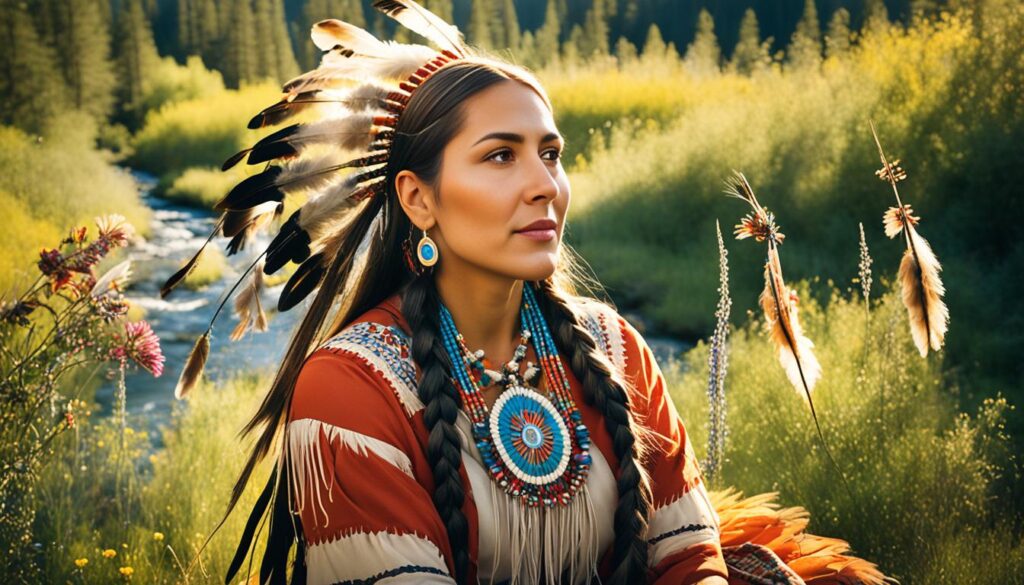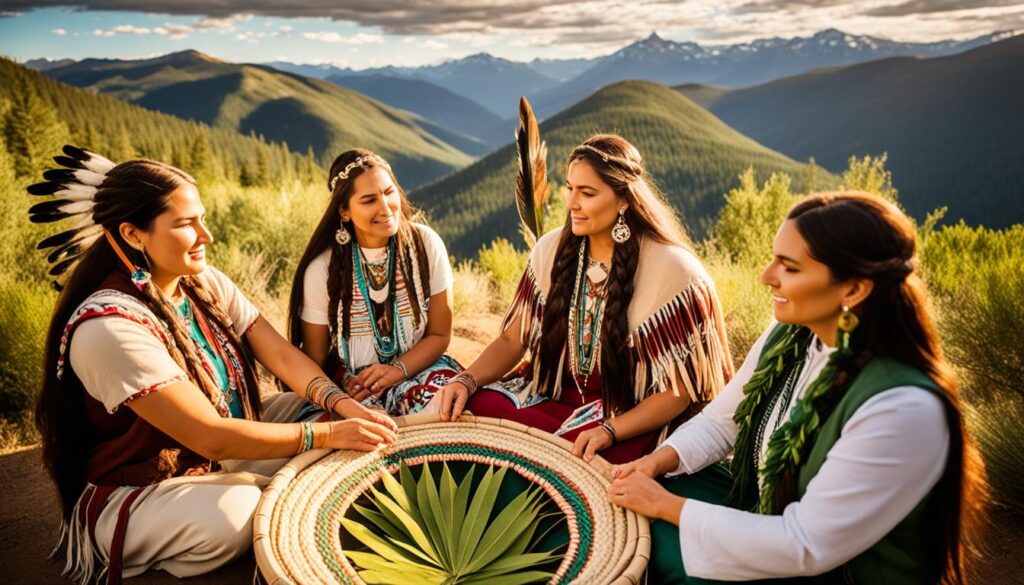
Have you ever wondered about the cultural importance of braids in India? How traditional Indian hairstyles have shaped the hair traditions in the country? Let’s explore the fascinating world of Indian hair culture and discover the symbolism behind Indian braids.
Key Takeaways:
- Indian braids hold significant cultural and religious symbolism.
- Braided hair represents unity, strength, and resistance against societal expectations.
- Neatly braided hair is seen as a symbol of discipline and adherence to gender norms in Indian culture.
- Long hair holds spiritual and symbolic significance in both Indian and Native American cultures.
- Braiding and grooming hair are bonding rituals within families and communities.
The Cultural and Religious Significance of Indian Braids
In Indian cultures, neatly braided hair holds immense cultural and religious significance. It serves as a symbol of discipline and domestication, reflecting a woman’s adherence to societal expectations and her character. Braided hairstyles have a long history in Indian culture, showcasing various textures, patterns, and intricacies that are deeply intertwined with religious and cultural practices.
Indian braids can be traced back to ancient times, exemplifying the historical evolution of hairstyles and the cultural values they represent. From simple and elegant braids to more elaborate and intricate styles, these traditional Indian hairstyles are a testament to the artistry and creativity of the Indian people.
Braiding rituals form an integral part of Indian culture, encompassing various rituals, ceremonies, and occasions. Braiding not only enhances the aesthetic appeal of the hair but also serves practical purposes. It allows for the incorporation of oils and nourishing ingredients, promoting healthy hair and scalp care.
“Braids not only adorn our hair, but they also weave together our rich heritage, traditions, and religious beliefs,” says Ritu Sharma, a renowned cultural historian.
“The act of braiding one’s hair is a sacred and deeply personal experience. It symbolizes the interconnectedness of body, mind, and spirit and the harmony between oneself and the divine.”
Religious Significance of Indian Braids
In Indian religions, such as Hinduism and Sikhism, braids hold profound religious significance. For example, among Sikhs, uncut hair and a knot at the crown, known as a “top knot” or “rishi knot,” represent a commitment to maintaining the natural form given by the Creator. It serves as a visual reminder to live in alignment with spiritual values, such as truth, honesty, and integrity.
Hindu rituals often involve the offering of braided hair as a form of devotion and surrender to the deities. The act of braiding hair for religious ceremonies is considered sacred and is believed to invoke divine blessings and protection.
Additionally, certain hairstyles and braiding patterns are associated with specific deities, symbolizing devotion and reverence. For instance, the “Jata” or “Jatadhari” hairstyle, characterized by matted dreadlocks, is closely associated with Lord Shiva, representing his ascetic and mystical nature.
Historical Indian Hairstyles
The history of Indian hairstyles is a tapestry of diverse influences and cultural exchanges. Different regions and time periods have given rise to unique hairstyles and braiding techniques that reflect the local customs, traditions, and prevailing fashion trends.
From elaborate bridal updos adorned with intricate jewelry to symmetrical braided patterns of North India, each hairstyle tells a story and carries its own symbolism. These styles have been passed down from generation to generation, preserving the legacy and cultural heritage of Indian communities.
Today, modern Indian hairstyles blend traditional elements with contemporary trends. Braids continue to be an integral part of Indian fashion, with fusion styles combining traditional braiding techniques with modern twists and adornments.
| Braiding Rituals | Religious Significance |
|---|---|
| Pull-through braids | A symbol of prosperity and marital harmony |
| French braids | Represent purity and feminine grace |
| Fishtail braids | Symbolize strength and protection |
| Traditional buns | Associated with auspicious occasions and ceremonial rituals |
The Symbolism of Long Hair in Native American Culture
In Native American culture, long hair holds immense significance, representing power, virility, and physical strength. It is more than just an aesthetic attribute; it is believed to be a sacred connection to Mother Earth and all living beings. Native Americans view hair as an extension of the nervous system and the soul, understanding its spiritual importance.

The act of braiding hair is deeply symbolic in Native American traditions. Braided hair symbolizes unity with the infinite or the Creator, highlighting the interconnectedness of all things. It signifies the strength and resilience of the individual and the community. In contrast, free-flowing hair represents the freedom of life, without constraints or limitations.
The cultural significance of hair extends to the historical context as well. During the era of boarding schools and assimilation efforts, Native Americans had their hair forcefully cut as a means of stripping them of their identity and culture. This traumatic practice aimed to erase their connection to their heritage and spirituality.
Native American customs and protocols around hair also emphasize respect and reverence. Touching someone’s hair without permission is considered disrespectful, as it is seen as an invasion of personal space and boundaries.
“Hair is the physical manifestation of our thoughts and an extension of ourselves. By cutting a person’s hair without permission, you are violating them both physically and spiritually.”
The Power of Long Hair in Native American Spirituality
The spiritual significance of hair in Native American culture cannot be understated. It is believed that hair carries energy and acts as a channel for spiritual connection. Native Americans view their long hair as a channel for receiving and transmitting spiritual energies and messages.
The act of cutting hair often accompanies significant life changes or periods of mourning. It holds a symbolic meaning, representing the release of the past or letting go of grief. Cutting hair during these moments acts as a ceremonial ritual, acknowledging the transition and honoring the connection between physical and spiritual realms.
Long hair traditions in Native American culture continue to be practiced and celebrated today, not just for their aesthetic appeal but for their deep spiritual significance. By understanding and honoring the symbolism of long hair, we can gain a deeper appreciation for the rich cultural heritage and spiritual beliefs of Native American communities.
The Importance of Family and Community in Hair Traditions
Hair holds a significant role in Native American cultures, serving as a powerful bond within families and communities. For generations, the act of braiding a child’s hair has been considered more than a simple hairstyle – it is a meaningful gesture of nurturing and intimacy. During pow-wows and other gatherings, it is common to witness family members and friends brushing and braiding each other’s hair, reinforcing the sacredness of their relationships and the strength of their community.
In Native American culture, hair symbolizes more than just an individual’s physical appearance. It represents the collective strength and unity of a community. While single strands of hair may be weak on their own, when braided together, they form a strong and resilient bond. This symbolism emphasizes the importance of interconnectedness and supporting one another.
The traditions, values, and creative self-expression of each family and tribe guide how they groom, style, and ornament their hair. Through various braiding techniques, unique patterns emerge, reflecting a sense of cultural identity and creativity. Hair becomes a canvas for individual and communal self-expression, serving as a visual representation of their shared heritage and traditions.

Through the act of braiding and caring for their hair, Native American communities foster a strong sense of belonging and unity. It is a way of preserving and passing down their traditions, values, and cultural knowledge from one generation to the next.
Conclusion
Hair holds a profound significance in the cultural and religious practices of Native American and Indian communities. It serves as a powerful symbol of cultural identity, self-respect, and the connection to one’s community, family, and spiritual beliefs. The art of braiding, in particular, carries deep symbolism of unity, strength, and resistance.
In recent years, there has been a growing movement to reclaim the symbolism of braids, challenging societal expectations and embracing them as a symbol of empowerment. By understanding and honoring the significance of Indian braids, we can appreciate and respect the rich traditions and cultural heritage associated with these intricate hairstyles.
The sacredness of hair in Native American and Indian cultures reminds us of the value of cultural diversity and the importance of preserving and celebrating our unique identities. Through the practice of braiding, individuals not only express their cultural pride but also strengthen their sense of self and connection to their communities. Let us embrace and support the reclaiming of the symbolism of braids as a testament to the power of cultural identity and self-expression.






